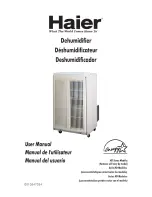
26
RTS HUMIDIFIER RX SERIES INSTALLATION, OPERATION, AND MAINTENANCE MANUAL
INSTALLATION
Piping: Drain water tempering
Table 26-3:
Mechanical tempering device capacities*
Maximum flow rate
Maximum temperature
gpm
L/m
°F
°C
Hot water inflow
6
22.7
212
100
Cold water inflow**
6
22.7
70
21
Tempered water outflow
12
45.4
140
60
Note:
*Table applicable with one humidifier connected to one tempering device,
with no more than 10' (3m) vertical distance between humidifier and
tempering device
** Cold water inflow pressure between 25 - 80 psi (172 - 552 kPa)
Table 26-1:
Mechanical tempering device connections
Hot water inlet
1" NPT
1" Hose*
Cold water inlet
3/4" NPT/BSP
3/8" NPT**
Tempered water outlet
1" NPT/BSP
N/A
*For remote applications, use hose connection at tempering device
**For independent tempering water supply, connect at thermostatic valve
Table 26-2:
Mechanical tempering device weights
lbs
kg
Dry weight
7.1
3.2
Shipping weight
7.6
3.4
Operating weight
9.8
4.4
Table 26-4:
Mechanical tempering device material
Component
Material
Tempering chamber 304 stainless steel
Valve body
Bronze
Vacuum breaker
Brass
HOW IT WORKS: HOT + COLD = TEMPERED
1. Hot water discharged from a humidifier enters the device through piping/
hose connected to the top (-1 and -2 stage RTS) or side (-3 and -4 stage
RTS) connection. A vacuum breaker prevents backflow into potable water
systems.
2. Cold water enters through the temperature-actuated valve. The valve and
the tempering device’s straightforward design ensure efficient mixing of
hot and cold water. The valve's sensor, located near the outlet, ensures
that water leaving the device is 140 °F (60 °C) or less before entering the
municipal sewer system.
3. Tempered water at 140 °F (60 °C) or less exits through the side outlet for
safe discharge into a municipal sewer system or PVC pipe.
MOUNTING OPTIONS
The mechanical tempering device can be mounted by attaching the integral
mounting plate to a wall or directly to the RTS humidifier.
















































